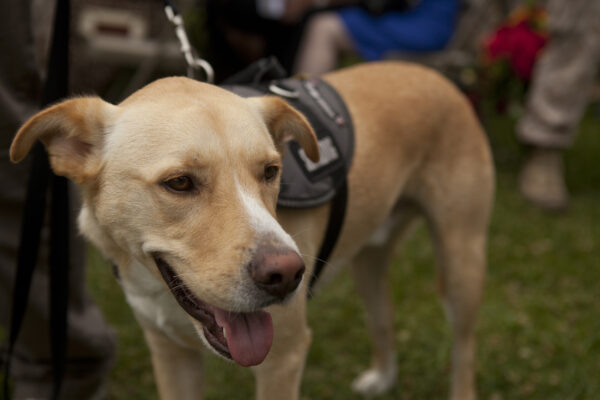
Luke, service dog, stands during a retirement ceremony for Maj. Gen. Charles M. Gurganus. (Photo: Lance Cpl. Christopher A. Mendoza)
During The American Legion’s National Convention on August 23, two distinct approaches to addressing PTSD and suicide prevention, each focusing on deep emotional healing and community support, were shared with the TBI/PTSD Suicide Prevention Committee in New Orleans, as reported by Steven B. Brooks.
Rick Yount, founder and CEO of Warrior Canine Connection, introduced the committee to his innovative therapy program that involves Veterans in the training of mobility service dogs for other Veterans. Yount launched the first therapeutic service dog training program at the Palo Alto, Calif., Veterans Hospital in 2008 and has been engaged in animal-assisted therapy for 22 years. He explained that the process of training these dogs helps Veterans improve their communication skills, emotional regulation, and patience. Each dog’s unique personality requires Veterans to learn flexibility and assertiveness without aggression.
The therapeutic value lies in the practice of patience, as Veterans must consistently adapt their training methods to earn the dogs’ respect. However, Yount pointed out a significant challenge: the limited availability of service dogs to meet the growing demand among Veterans. To address this, WCC has partnered with American Legion Post 295 in Germantown, Md., to recruit volunteers who will raise and train puppies for the program. This program not only supports Veterans but also fosters community involvement in addressing a critical need.
Dr. Jake Clark, president and founder of Save a Warrior, presented another approach focused on addressing the root causes of Veteran suicides. Clark’s program, based in Ohio, offers a 72-hour residential experience designed to confront and resolve moral injuries and complex PTSD through ceremonies, rituals, and storytelling.
“I’m here to let you know that we’re not looking at the problem… why so many Veterans are killing themselves,” said Clark. “We are looking at the issue and have been the last 12 years. And it was not what we thought it was going to be.”
Clark shared that his work has revealed that the primary underlying issue for many Veterans is unresolved childhood trauma, particularly neglect, sexual abuse, and dysfunctional family dynamics. He stressed the importance of providing a safe space for Veterans to express and process these deep-seated traumas. Clark’s approach is supported by testimonials from those who have experienced its transformative impact, including Pam Krill, a three-time combat Veteran, who credited SAW with saving her life and shifting her perspective on her struggles.
“It is transformational. That program saved me,” Krill said.